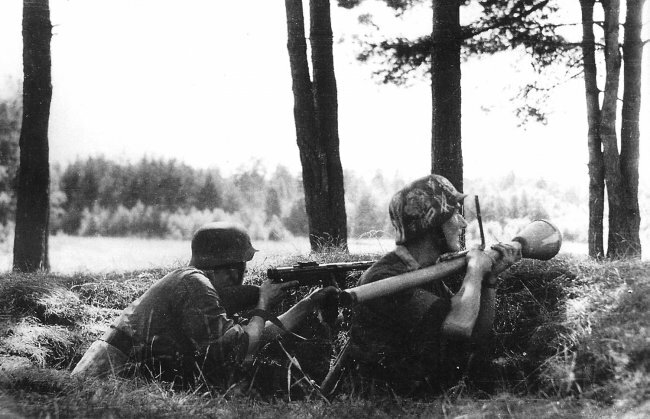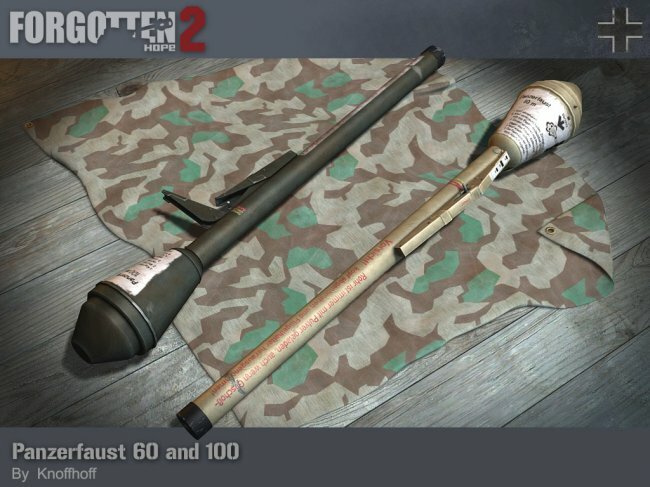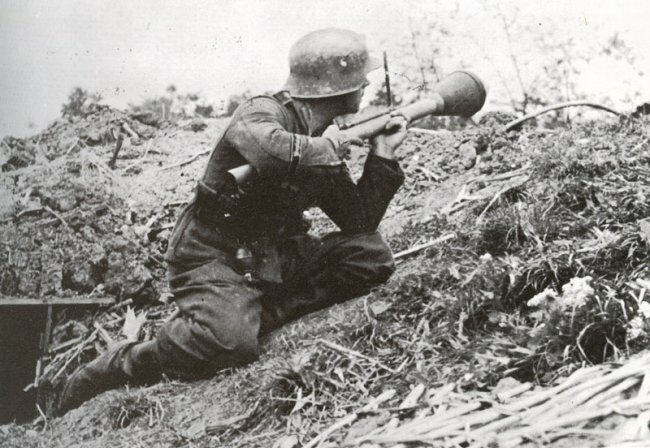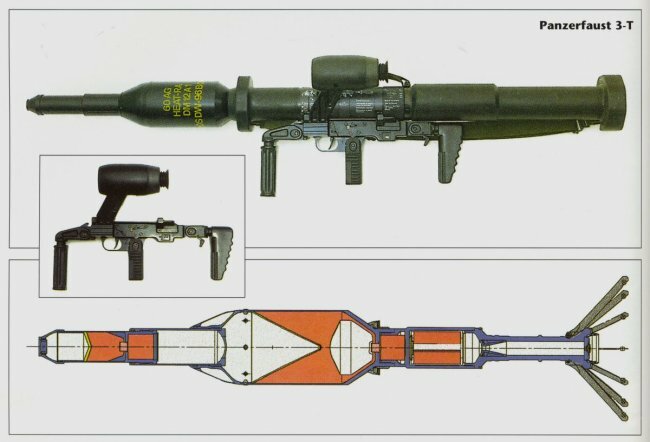Panzerfaust, Panzerknacke, Panzerschrec
The Wehrmacht doctrine provided for the use of anti-tank guns by the infantry in defense and attack, but in 1942 the German command fully realized the weakness of mobile anti-tank weapons: light 37-mm guns and anti-tank rifles could no longer effectively hit medium and heavy Soviet Tanks.
In 1942, Hasag presented the German command model Panzerfaust (in Soviet literature it is better known as “Faustpatron” - Faustpatrone). The first model of the Heinrich Langweiler Panzerfaust 30 Klein grenade launcher (small) had a total length of about one meter and weighed three kilograms. The grenade launcher consisted of a barrel and an over-caliber grenade of cumulative action. The barrel was a pipe with smooth walls of length 70 cm and diameter 3 cm; Weight - 3,5 kg. Outside the barrel was a percussion mechanism, and inside was placed a propellant charge consisting of a powder mixture in a cardboard container.
The grenade thrower pressed the trigger, the drummer put a cap on it, igniting the powder charge. Owing to the formed powder gases, the grenade flew out of the barrel. A second after the shot, the blades of the grenade opened - to stabilize the flight. The relative weakness of the expelling charge caused the lifting of the trunk at a significant elevation angle when firing at a distance of 50-75 meters. The maximum effect was achieved when firing at a distance of up to 30 meters: at an angle of 30 degrees, the grenade was able to penetrate the 130-mm armor sheet, which at that time guaranteed the destruction of any allied tank.
The cumulative Monroe principle was used in the ammunition: the high-explosive charge from the inside had a cone-shaped notch covered with copper, with a wide part ahead. When the projectile hit the armor, the charge detonated at some distance from it, and the whole force of the explosion rushed forward. The charge burned through the copper cone at its top, which, in turn, created the effect of a thin directional jet of molten metal and hot gases that hit the armor at a speed of about 4000 m / s.
After a series of tests, the grenade launcher entered service with the Wehrmacht. In the autumn of 1943, Langweiler received many complaints from the front, the essence of which was that the Klein grenade often gave bounce from the bowed armor of the Soviet T-34 tank. The designer decided to follow the path of increasing the diameter of the cumulative grenade, and in the winter of 1943, the model Panzerfaust 30M appeared. Due to the increased cumulative funnel, armor penetration was 200 mm of armor, but the firing range fell to 40 meters.
For three months, 1943, the German industry has released 1300000 "Panzerfaustov." Khasag has constantly improved its grenade launcher. Already in September, Panzerfaust 1944M was launched into serial production, the range of which due to an increase in the powder charge increased to sixty meters.
In November of the same year, the Panzerfaust 100M appeared with an enhanced powder charge, which allowed firing at a distance of up to one hundred meters. “Faustpatron” - single-use RPG, but the lack of metal forced the Wehrmacht command to oblige the rear supply parts to collect used “Faust” trunks for their recharging in factories.
The scale of use of Panzerfaust is amazing - in the period from October 1944-th to April 1945, 5600000 "faust-cartridges" of all modifications were produced. The presence of such a number of disposable hand-held anti-tank grenade launchers (RPGs) in the last months of World War II allowed the untrained boys from Volkssturm to inflict considerable damage on Allied tanks in urban battles.
Interestingly, the allies did not disdain to use captured RPGs. Since the Soviet army had no such weapons, Russian soldiers regularly used captured grenade launchers to fight tanks, as well as in urban battles, to suppress enemy fortified firing points.
From the speech of Colonel-General V.I., commander of the 8 Guards Army. Chuikova: “Once again, I want to especially emphasize at this conference the large role that the enemy’s weapons played - these are faust-patrons. 8-i guv. the army, soldiers and commanders, were in love with these faustprony, stole them from each other and used them successfully - effectively. If it is not a faustpatron, then let's call it Ivan-patron, if only we would have it as soon as possible. ”
Armor Tongs
A smaller copy of the Panzerfaust was the Panzerknacke grenade launcher (“Pliers for armor”). They were equipping saboteurs, and with this weapon the Germans planned to liquidate the leaders of the countries of the anti-Hitler coalition.
On a moonless September night, 1944, a German transport plane landed on a field in the Smolensk region. From it, a motorcycle was rolled out along a retractable gangway, in which two passengers - a man and a woman in the form of Soviet officers - left the landing site, driving towards Moscow. At dawn, they were stopped to check the documents that were in order. But an employee of the NKVD drew attention to the clean form of the officer - after all, it had rained heavily the night before. The suspicious couple was detained and after checking handed over to SMERSH. These were the saboteurs Politov (aka Tavrin) and Shilov, who were trained by Otto Skorzeny himself. In addition to a set of fake documents, the “Major” even had fake clippings from the newspapers “Pravda” and “Izvestia” with essays on exploits, decrees on awarding and a portrait of Major Tavrin. But the most interesting thing was in Shilova’s suitcase: a compact magnetic mine with a radio transmitter for a remote detonation and a Panzernakke compact rocket launcher.
The armored tongs length was 20 cm, and the launch tube was 5 diameter, cm.
A missile was worn on the pipe, which had a range of thirty meters and pierced the armor with a thickness of 30 mm. "Panzerknakke" was attached to the forearm arrow with leather straps. In order to secretly wear a grenade launcher, Politova sewed a leather coat with an extended right sleeve. The grenade was launched by pressing a button on the wrist of the left hand - the contacts were closed, and the current from the battery, hidden behind the belt, initiated the “Panzernakke” fuse. This "miracle weapon" was intended to kill Stalin during a trip on an armored car.
Panzerschreck
In 1942, the sample of the American Bazooka’s M1 American anti-tank grenade launcher (caliber 58 mm, weight 6 kg, length 138 cm, target range 200 meters) fell into the hands of German designers. The Wehrmacht Armaments Directorate proposed to weapons companies a new technical task for constructing a Raketen-Panzerbuchse hand-held grenade launcher (missile tank rifle) based on the Bazuki trophy. Three months later, a prototype was ready, and after testing 1943 in September, the German RPG Panzerschreck - “Thunderstorm of Tanks” - was adopted by the Wehrmacht. This efficiency was possible due to the fact that German designers have already conducted work on the design of a rocket launcher.
The “Thunderstorm of Tanks” was an open smooth-walled tube of length 170 cm. Inside the tube there were three guides for a missile. For aiming and carrying used shoulder rest and handle to hold the RPG. Charging was carried out through the tail pipe. For firing, the grenade thrower aimed a Panzerschreck at the target using a simplified aiming device, which consisted of two metal rings. After pressing the trigger, a small magnetic rod was introduced into the induction coil (as in piezo lighters), as a result of which an electric current was generated which, passing through the wiring to the back of the launch tube, initiated the ignition of the projectile powder engine.
The construction of the Panzershrek (the official name of 8,8 cm Raketenpanzerbuechse-43 - “88-mm missile anti-tank gun of the 1943 model of the year”) turned out to be more successful and had several advantages compared to the American equivalent:
The Thunderstorm Tank had a caliber of 88 mm, and an American RPG - 60 mm. Due to the increase in caliber, the weight of the ammunition has doubled, and therefore the armor-piercing rate has increased. The cumulative charge punched homogeneous armor up to 150 mm thick, which guaranteed the destruction of any Soviet tank (the American upgraded version of the Bazooka М6А1 punched armor to 90 mm).
An induction current generator was used as a trigger mechanism. On the "Bazooka" used the battery, which was quite capricious in operation, and at low temperatures lost charge.
Because of the simplicity of its design, the Pantsershrek provided a high rate of fire of up to ten rounds per minute (for Bazuki, 3-4).

The Panscherhrek projectile consisted of two parts: a combat with a shaped charge and a reactive unit. To use the RPG in different climatic zones, the German designers created an “arctic” and “tropical” modification of the grenade.
To stabilize the flight path of the projectile a second after a shot, a ring of thin metal was ejected in the tail section. After the projectile was removed from the launch tube, the gunpowder charge continued to burn for another two meters (for this, the German soldiers called Ofcnrohr “Pantsershrek”, a chimney). To protect himself from burns when firing, the grenade thrower had to wear a gas mask without a filter and put on thick clothes. This disadvantage was eliminated at a later modification of the RPG, on which a protective screen with a window for aiming was installed, which, however, increased the weight to eleven kg.

Due to its low cost (70 Reichsmarks - comparable to the price of a Mauser 98 rifle), as well as a simple device with 1943 to 1945, more than 300000 copies of the Panzerschreka were released. In general, despite the shortcomings, the “Thunderstorm of tanks” has become one of the most successful and effective weapons of the Second World War. Large dimensions and weight fettered the actions of the grenade thrower and did not allow to quickly change the firing position, and this quality in battle is priceless. Also, when shooting it was necessary to make sure that behind the gunner RPG is not, for example, a wall. This limited the use of "Panzershreka" in urban environments.

It was the German RPGs that became the progenitors of the modern "tank killers." The first Soviet RPG-2 grenade launcher was put into service in the 1949 year and repeated the “Panzerfaust” scheme.




Information